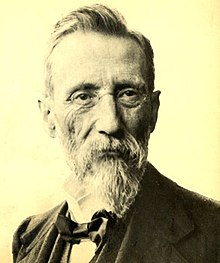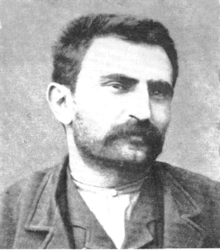Anarchism is a political philosophy and movement that is against all forms of authority and seeks to abolish the institutions it claims maintain unnecessary coercion and hierarchy, typically including the state and capitalism. Anarchism advocates for the replacement of the state with stateless societies and voluntary free associations. A historically left-wing movement, anarchism is usually described as the libertarian wing of the socialist movement.
Anarchist communism is a far-left political ideology and anarchist school of thought that advocates communism. It calls for the abolition of private property but retention of personal property and collectively-owned items, goods, and services. It supports social ownership of property and the distribution of resources.
Anarcho-syndicalism is an anarchist organisational model that centres trade unions as a vehicle for class conflict. Drawing from the theory of libertarian socialism and the practice of syndicalism, anarcho-syndicalism sees trade unions as both a means to achieve immediate improvements to working conditions and to build towards a social revolution in the form of a general strike, with the ultimate aim of abolishing the state and capitalism. Anarcho-syndicalists consider trade unions to be the prefiguration of a post-capitalist society and seek to use them in order to establish workers' control of production and distribution. An anti-political ideology, anarcho-syndicalism rejects political parties and participation in parliamentary politics, considering them to be a corrupting influence on the labour movement. In order to achieve their material and economic goals, anarcho-syndicalists instead practice direct action in the form of strike actions, boycotts and sabotage. Anarcho-syndicalists also attempt to build solidarity among the working class, in order to unite workers against the exploitation of labour and build workers' self-management.
Anarchism in Spain has historically gained some support and influence, especially before Francisco Franco's victory in the Spanish Civil War of 1936–1939, when it played an active political role and is considered the end of the golden age of classical anarchism.
According to different scholars, the history of anarchism either goes back to ancient and prehistoric ideologies and social structures, or begins in the 19th century as a formal movement. As scholars and anarchist philosophers have held a range of views on what anarchism means, it is difficult to outline its history unambiguously. Some feel anarchism is a distinct, well-defined movement stemming from 19th-century class conflict, while others identify anarchist traits long before the earliest civilisations existed.
Mutualism is an anarchist school of thought and economic theory that advocates for workers' control of the means of production, a market economy made up of individual artisans and workers' cooperatives, and occupation and use property rights. As proponents of the labour theory of value and labour theory of property, mutualists oppose all forms of economic rent, profit and non-nominal interest, which they see as relying on the exploitation of labour. Mutualists seek to construct an economy without capital accumulation or concentration of land ownership. They also encourage the establishment of workers' self-management, which they propose could be supported through the issuance of mutual credit by mutual banks, with the aim of creating a federal society.

The Jura Federation represented the anarchist, Bakuninist faction of the First International during the anti-statist split from the organization. The Canton of Jura, a Swiss area, was known for its watchmaker artisans in La Chaux-de-Fonds, who shared anti-state, egalitarian views on work and social emancipation. The Jura Federation formed between international socialist congresses in 1869 and 1871. When the First International's General Council, led by Marxists, suppressed the Bakuninists, the Jura Federation organized the Anarchist St. Imier International of the disaffected federations at the 1872 St. Imier Congress.
Anarchism without adjectives is a pluralist tendency of anarchism that opposes sectarianism and advocates for cooperation between different anarchist schools of thought. First formulated by the Spanish anarchists Ricardo Mella and Fernando Tarrida del Mármol, as a way to bridge the ideological divide between the collectivists and communist factions, it was later adopted by the Italian anarchist Errico Malatesta and the American individualist Voltairine de Cleyre.

Fernando Tarrida del Mármol was a mathematics professor born in Cuba and raised in Catalonia best known for proposing "anarchism without adjectives", the idea that anarchists should set aside their debates over the most preferable economic systems and acknowledge their commonality in ultimate aims.
Italian anarchism as a movement began primarily from the influence of Mikhail Bakunin, Giuseppe Fanelli, Carlo Cafiero, and Errico Malatesta. Rooted in collectivist anarchism and social or socialist anarchism, it expanded to include illegalist individualist anarchism, mutualism, anarcho-syndicalism, and especially anarcho-communism. In fact, anarcho-communism first fully formed into its modern strain within the Italian section of the First International. Italian anarchism and Italian anarchists participated in the biennio rosso and survived Italian Fascism, with Italian anarchists significantly contributing to the Italian Resistance Movement. Platformism and insurrectionary anarchism have long been particularly common in Italian anarchism and continue to influence the movement today. The synthesist Italian Anarchist Federation and insurrectionary Informal Anarchist Federation appeared after the war, and autonomismo and operaismo especially influenced Italian anarchism in the second half of the 20th century.
The following outline is provided as an overview of and topical guide to anarchism:
Workers' Solidarity was a regional federation of trade unions in Catalonia. Established in 1907, following a series of unsuccessful attempts to establish a national trade union centre in Spain, SO united many of Barcelona's disparate anarchist and socialist trade unions into a single federation. The two factions of the organisation struggled to influence it in their favoured direction, while also clashing with the Radical Republican Party (PRR). In 1909, SO organised a general strike in Catalonia, which escalated into an insurrection known as the Tragic Week. The organisation was suppressed in the wake of the uprising, but managed to reorganise itself following the rise to power of a liberal government. In 1910, it merged together with other regional trade union federations into the National Confederation of Labour (CNT).
Antoni Pellicer i Paraire (1851–1916) was a Catalan writer, typographer and anarchist activist.

Rafael Farga i Pellicer was a Catalan anarcho-syndicalist who led the establishment of the Spanish Regional Federation of the IWA (FRE-AIT). As a print worker, he became involved in the Barcelona workers' movement following the Glorious Revolution of 1868, when he was first introduced to anarchism by the Italian anarchist Giuseppe Fanelli. He then set about organising the Catalan workers' movement along anarchist lines, emphasising decentralisation and federalism, eventually affiliating the FRE-AIT with Mikhail Bakunin's Anti-Authoritarian International. He then came to uphold the precepts of anarcho-syndicalism, overseeing the establishment of the FRE-AIT's successor, the Federation of Workers of the Spanish Region (FTRE). Later in life, he lost interest in syndicalist organising and turned to journalism, penning a series of studies of political figures and movements of the 19th century.
Social anarchism, also known as left-wing anarchism or socialist anarchism, is the branch of anarchism that sees liberty and social equality as interrelated.

The Spanish Regional Federation of the International Workingmen's Association, known by its Spanish abbreviation FRE-AIT, was the Spanish chapter of the socialist working class organization commonly known today as the First International. The FRE-AIT was active between 1870 and 1881 and was influential not only in the labour movement of Spain, but also in the emerging global anarchist school of thought.
The Pact of Union and Solidarity, also known as the Federation of Resistance to Capital, was a Spanish trade union federation that operated during the 1890s. Founded by Catalan collectivists and syndicalists within the existing Federation of Workers of the Spanish Region (FTRE), the PUS sought to unify trade unions around demands for the eight-hour day. It was a more decentralised organisation than the FTRE and permitted workers of all socialist schools of thought. Together with the Anarchist Organisation of the Spanish Region (OARE), in 1888, the PUS voted to dissolve the FTRE. It briefly continued organising as an independent trade union federation, but after a rise in anarchist terrorism provoked political repression by the Spanish state, its activities were limited. By 1893, it had largely stopped functioning. Following the arrest of hundreds of anarchists in the Montjuïc trial, it finally dissolved itself in 1896. After a resurgence in trade union activity, it was succeeded by the Federation of Workers' Societies of the Spanish Region (FSORE) in 1900.
The Federation of Workers' Societies of the Spanish Region, also known as the Federation of Resistance Societies of the Spanish Region, was a Spanish anarcho-syndicalist trade union federation which was active during the early 1900s. Following a period of economic crisis in Spain and the political repression of the anarchist movement during the previous decade, in 1900, Spanish trade unions came together to establish the FSORE as a means to coordinated solidarity between workers of different trades. The FSORE quickly grew to become the largest trade union federation in the country, although it faced difficulties organising workers due to the rapid advance of industrialisation and the entry of women in the workforce. The FSORE organised a number of strike actions in 1901 and 1902, particularly in Catalonia, culminating in the country's first general strike in Barcelona. The general strike was defeated and the trade union movement was suppressed, but a wave of strikes continued over the subsequent two years. By the mid-1900s, the FSORE had lost most of its support and went into a decline, formally dissolving in 1907. It was succeeded by the Barcelona trade union federation Workers' Solidarity (SO), which formed the nucleus for the National Confederation of Labour (CNT), founded in 1910.
The Disinherited was a Spanish clandestine anarchist group that defended the use of violence framed in the doctrine of propaganda of the deed.
Francesc Tomàs Oliver (1850–1903) was a Spanish anarchist, a bricklayer by profession, who said that the labor movement had to be led by "workers with calluses on their hands." A member of the Federal Commission of the Spanish Regional Federation of the International Workingmen's Association (1870–1881) and of its successor the Federation of Workers of the Spanish Region (1881–1888), he was the author of the first history of the beginnings of anarchism in Spain in the form of 16 articles that appeared in La Revista Social between December 27, 1883, and January 15, 1885, with the title Del nacimiento de las ideas anárquico-colectivista en España.







